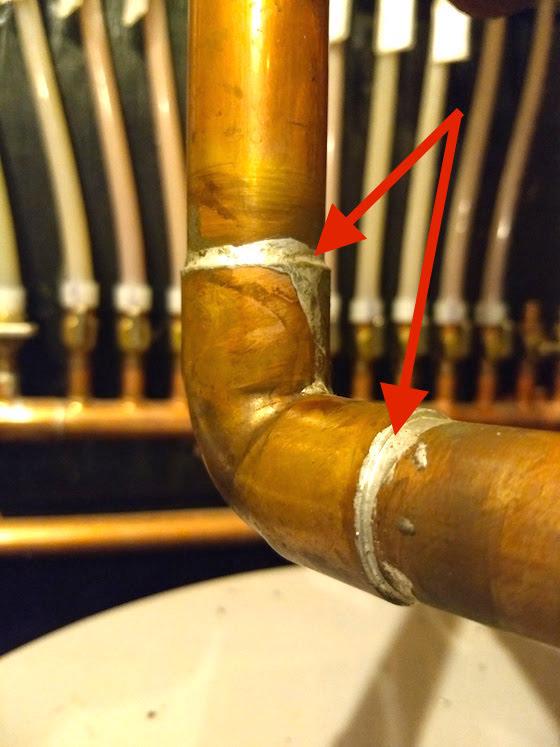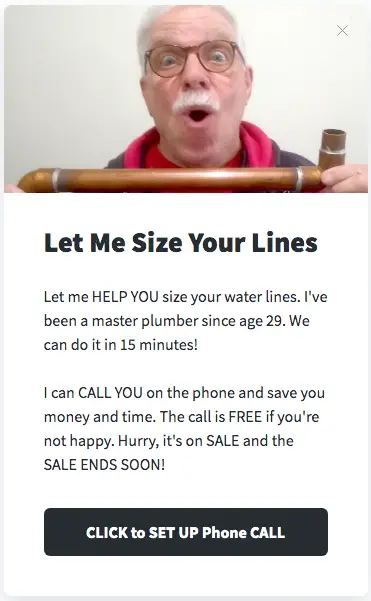Properly Size Your Water Lines

Size water line - The red arrows point to a large-diameter 1-inch feed line for all the hot water in a home. Behind it on the wall are smaller-diameter 5/8-inch supply lines to each fixture. Copyright 2021 Tim Carter
"Waterline size determines the amount of water flowing from a pipe. Bigger is better if you want lots of water in a short time."
Revised February 2021
Size Water Line TIPS
- Larger diameter water lines create less friction
- 1-inch pipe less than 100 feet to a house is good
- Size Water Line Videos BELOW
- 8-inch-diameter water main supplies hundreds of homes
- CLICK HERE to get Tim's FREE AsktheBuilder Newsletter - He's a master plumber!
My guess is that most people don't think twice about the water that will flow from the faucets in their new homes. You may not even give a second thought to the noise water makes when rushing through water lines.
Because you are moving into a new home, my guess is you might assume a waterfall of water will cascade from each faucet and hose bib.
Don't count on it. Your builder or plumber may have made a few mistakes that can restrict the amount of water that flows from faucets. These same mistakes can also cause significant water pipe noise that drowns out conversation and other pleasant sounds around your home.
Related Links
Low Water Pressure Common Causes
Old Water Pipes Create Water Flow Problems
Free & Fast Bids
CLICK HERE to get FREE & FAST BIDS from plumbers in your city or town to help increase your water pressure.
Bigger is Absolutely Better
If you are in the planning stages of building, you can correct these problems before they happen. A water supply pipe of a given size can only supply a given quantity of water at a given pressure and a given hydrostatic head. Hydrostatic head commonly refers to the vertical distance a water line extends.
Size Water Line Video
This short video is fantastic. Pay attention to the first two numbers he quotes!!! HUGE difference in volume for just a tiny increase in pipe diameter!
If you live near a water tower, you want to be as far downhill from it as possible. Usually, these towers are placed at high points in the landscape. To have the best water pressure, you want to be in a valley with as much vertical distance as possible between you and the bottom of the tank. The greater this distance, the greater the hydrostatic pressure.
High Water Pressure From Elevation
In Cincinnati, Ohio for example, if you have a home in the Mill Creek valley below all the hills above you where the water tanks are, your water pressure could easily be in excess of 200 pounds per square inch (PSI). The land above the valley is 400 feet higher in elevation. The weight of the water in the pipes between the valley and the hills above presses down and creates very high pressure.
If you are trying to push water up a pipe from a basement to a second floor, gravity is doing its best to exert an opposite force against the water pressure. Gravity becomes your friend and increases water pressure if you store your water up on your roof, but how many people do you know have 5,000-gallon storage tanks in their attics?
This is what you'll find in large office towers, hotels, hospitals and other buildings where lots of people could be using the plumbing system at the same time.
3/4 Inch Is Okay | 1 Inch Is Better
You need to have lots of water capacity coming into your home, even if you don't need it all the time. For most homes in most cities, a 3/4-inch line might be sufficient, but if you have the opportunity to specify the pipe size, put in a 1-inch line. I'm a master plumber and believe me, you'll never regret doing it.
Plumbers and builders know that people rarely turn on more than three or four plumbing faucets at the same time. But it can happen.
If you want a plentiful supply of water to flow from each faucet, you must be certain that the main water line entering the house and the main feed line within the house is at least three-quarter inch in diameter or possibly one-inch in diameter. This larger sized pipe can carry a significant amount of water.
Size Water Line Software
Watch this short video to see computer software that will help you SIZE your water lines. It's from Australia, but the principals are the same all over the world.
CLICK HERE to get FREE & FAST BIDS from plumbers in your city or town to help increase your water pressure.
Rural Well Water Pipes
Be sure your well digger puts in a 1 and 1/4-inch plastic line from the well to the inside of your home. Usually, it's a short distance and you'll never regret the larger pipe. Remember, it's easy to put in the right size pipe when the trench is open. If you try to do it later, it's an enormous, expensive, job.
If your home is far away from the water main, up a hill and it's a monster job to install a water line, you can't make a mistake. It's well worth a $500 fee, even $750, to pay a mechanical engineer to size the water line you need. It's very possible you may need a 2 or 2.5-inch diameter water line if your home is 500, or 1,000, feet from the city water main. Do NOT GUESS. You'll regret it.
Install Large Pipes to ALL Bathrooms!
All too often, a rookie plumber might start to prematurely reduce the size of the water lines in a home. If you see one-half inch diameter water lines that serve two or more fixtures, trouble may be just around the corner. If your new home has three or more bathrooms, consider keeping the cold water pipe size one inch until it has served the water heater, the first bathroom group and possibly one or two outdoor hose bibs.
The main water line can then be reduced to three-quarter inch diameter to serve the remaining bathrooms, laundry room, hose bibs, etc. One-half inch diameter pipes can branch off the three-quarter inch line to serve individual fixtures. Extend the three-quarter inch line until you get to the final two or three fixtures in the house.
This is very important if you want great pressure and volume in all bathrooms.
Large-Diameter Pipes are Quieter
Pipe noise is also a function of pipe size. Larger diameter pipes create less noise because the velocity of the water moving through the pipe towards the fixture is lower. You can also minimize pipe noise by specifying a thicker pipe size.
If you are using copper tubing in your new home, it is very likely that type M copper will be used indoors. This is the thinnest pipe allowed by most plumbing codes. Thin pipes transmit noise more readily than thicker-walled pipes.
Use Thicker Pipes Too
The next thicker pipe type is L copper. Look at a piece of L vs. M copper and you will not see any difference. But pick up a 10-foot long piece of each and you will immediately realize the type L copper weighs more. This extra copper absorbs sound.
The fantastic news is that the cost upgrade for type L copper in a typical residential home is less than $275.00. (2017 prices) This is a one-time fee that allows you to have quiet water supply piping for the life of the home. It is a very small price to pay for peace and quiet.
Drill Large Pass-Through Holes
Finally, be sure the pipes are not in a bind as they pass through wall studs, wall plates and floor joists. The holes need to be slightly oversized so the water pipes can expand and contract freely.
Pieces of rubber that absorb vibration can also be installed between the pipes and any wood framing. Installing the strips of rubber can be a hassle, but any acoustical engineer will tell you it helps to stop noise transmission.
CLICK HERE to get FREE & FAST BIDS from plumbers in your city or town to help increase your water pressure.
Bulletin NH007

32 Responses to Properly Size Your Water Lines